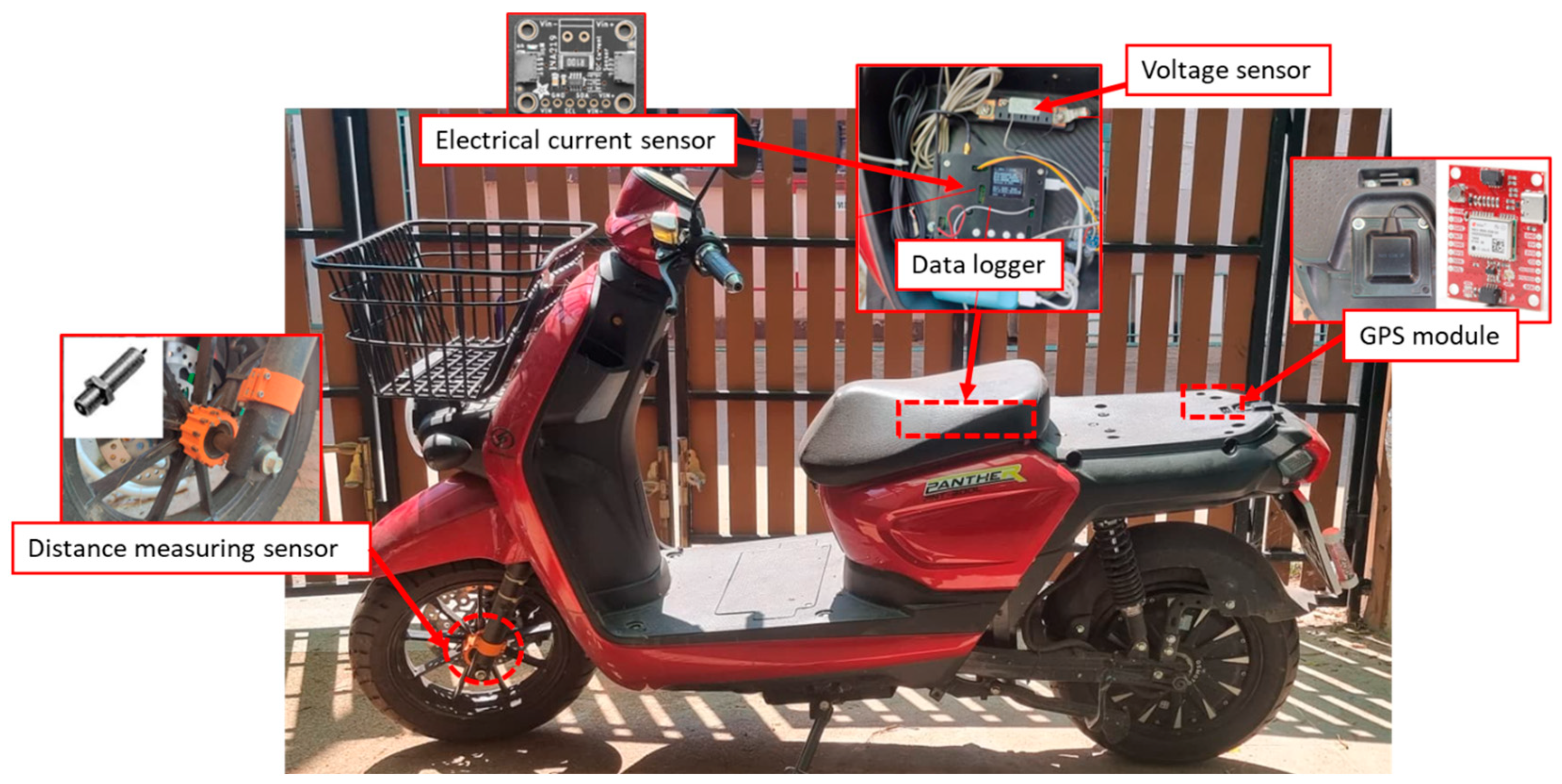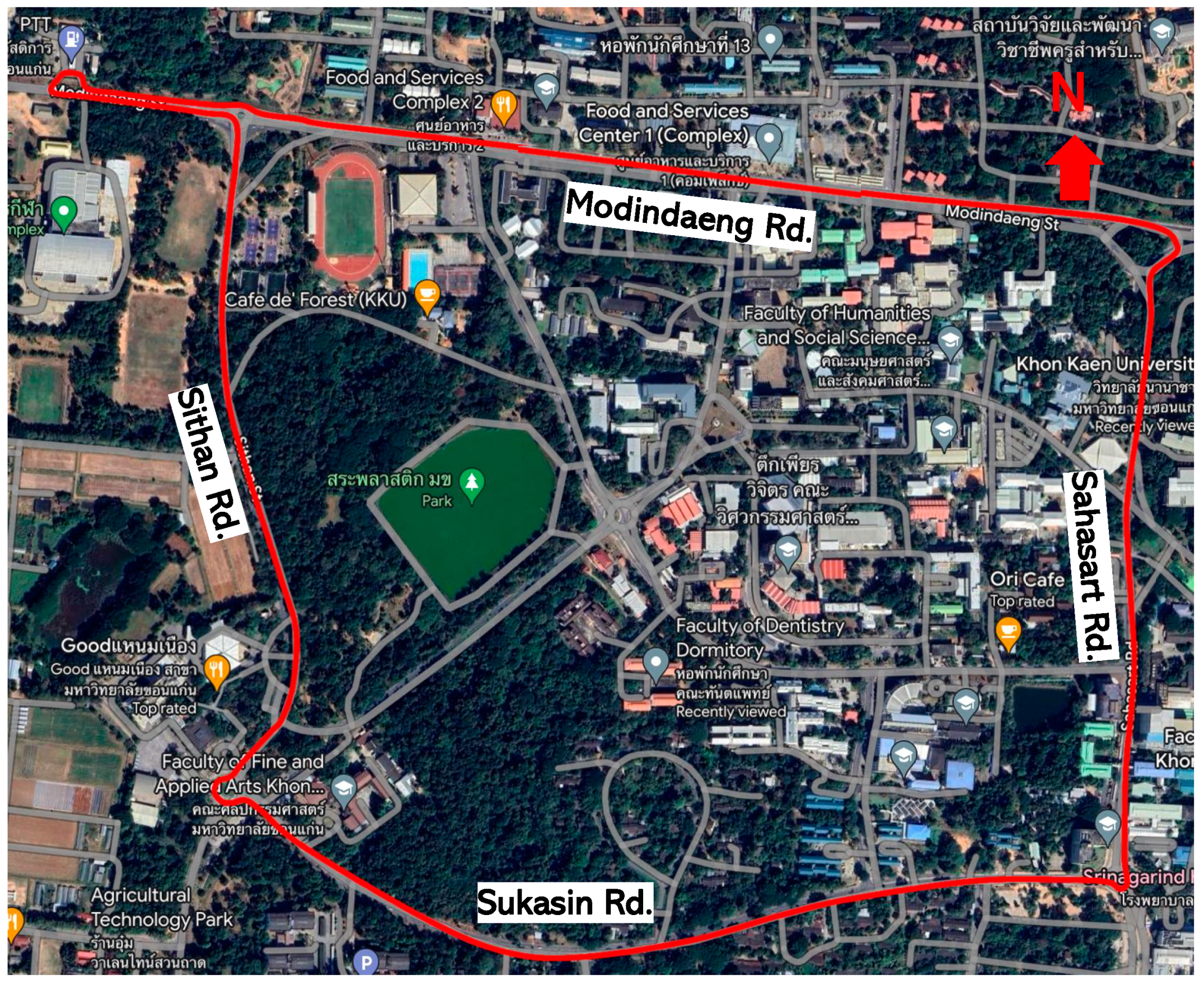Factors Influencing the Real-World Electricity Consumption of Electric Motorcycles
Abstract
:1. Introduction
2. Literature Review
| Authors | Types of Vehicles and Roads | Estimations/Collections | Influencing Factors |
|---|---|---|---|
| Sweeting et al. (2011) [13] |
|
|
|
| Yao et al. (2013) [19] |
|
|
|
| Saxena et al. (2014) [11] |
|
|
|
| Wu et al. (2015) [14] |
|
|
|
| Li et al. (2016) [21] |
|
|
|
| Wager et al. (2016) [16] |
|
|
|
| Galvin (2017) [15] |
|
|
|
| Farzaneh et al. (2018) [20] |
|
|
|
| Liao et al. (2021) [18] |
|
|
|
| Mavlonov et al. (2023) [22] |
|
|
|
3. Research Methodology
3.1. Development of On-Board Measurement Device
3.2. Real-World Data Collection
3.3. Data Analysis
4. Results and Discussions
4.1. Validation Results of Developed On-Board Measurement Device
4.2. Results of Real-World Data Collection
4.3. Results of Multiple Linear Regression Analysis
5. Conclusions and Recommendations
Author Contributions
Funding
Data Availability Statement
Conflicts of Interest
References
- IEA. Energy Technology Perspectives 2012: Pathways to a Clean Energy System; IEA: Paris, France, 2012. [Google Scholar]
- UNEP. Emissions Gap Report 2020; UNEP: Nairobi, Kenya, 2020. [Google Scholar]
- Koossalapeerom, T.; Satiennam, T.; Satiennam, W.; Leelapatra, W.; Seedam, A.; Rakpukdee, T. Comparative Study of Real-World Driving Cycles, Energy Consumption, and CO2 Emissions of Electric and Gasoline Motorcycles Driving in a Congested Urban Corridor. Sustain. Cities Soc. 2019, 45, 619–627. [Google Scholar] [CrossRef]
- Vanatta, M.; Rathod, B.; Calzavara, J.; Courtright, T.; Sims, T.; Saint-Sernin, É.; Clack, H.; Jagger, P.; Craig, M. Emissions Impacts of Electrifying Motorcycle Taxis in Kampala, Uganda. Transp. Res. Part D Transp. Environ. 2022, 104, 103193. [Google Scholar] [CrossRef]
- IEA Global Share of Electricity Generation. Available online: https://view.officeapps.live.com/op/view.aspx?src=https%3A%2F%2Fwww.eppo.go.th%2Fepposite%2Fimages%2FEnergy-Statistics%2Fenergyinformation%2FEnergy_Statistics%2FElectricity%2FT05_02_03.ppt&wdOrigin=BROWSELINK (accessed on 20 January 2023).
- EPPO. Share of Power Generation by Fuel Type, Thailand; EPPO: Bangkok, Thailand, 2022. [Google Scholar]
- IEA. Global EV Outlook 2022: Securing Spplies for an Electric Future; IEA: Paris, France, 2022. [Google Scholar]
- Michael, L.K.; KV, S.; Hungund, S.S.; Fernandes, M. Factors Influencing Adoption of Electric Vehicles–A Case in India. Cogent Eng. 2022, 9, 2085375. [Google Scholar] [CrossRef]
- Guerra, E. Electric Vehicles, Air Pollution, and the Motorcycle City: A Stated Preference Survey of Consumers’ Willingness to Adopt Electric Motorcycles in Solo, Indonesia. Transp. Res. Part D Transp. Environ. 2019, 68, 52–64. [Google Scholar] [CrossRef]
- Li, W.; Long, R.; Chen, H.; Geng, J. A Review of Factors Influencing Consumer Intentions to Adopt Battery Electric Vehicles. Renew. Sustain. Energy Rev. 2017, 78, 318–328. [Google Scholar] [CrossRef]
- Saxena, S.; Gopal, A.; Phadke, A. Electrical Consumption of Two-, Three- and Four-Wheel Light-Duty Electric Vehicles in India. Appl. Energy 2014, 115, 582–590. [Google Scholar] [CrossRef]
- Kusalaphirom, T.; Satiennam, T.; Satiennam, W.; Seedam, A. Development of a Real-World Eco-Driving Cycle for Motorcycles. Sustainability 2022, 14, 6176. [Google Scholar] [CrossRef]
- Sweeting, W.J.; Hutchinson, A.R.; Savage, S.D. Factors Affecting Electric Vehicle Energy Consumption. Int. J. Sustain. Eng. 2011, 4, 192–201. [Google Scholar] [CrossRef]
- Wu, X.; Freese, D.; Cabrera, A.; Kitch, W.A. Electric Vehicles’ Energy Consumption Measurement and Estimation. Transp. Res. Part D Transp. Environ. 2015, 34, 52–67. [Google Scholar] [CrossRef]
- Galvin, R. Energy Consumption Effects of Speed and Acceleration in Electric Vehicles: Laboratory Case Studies and Implications for Drivers and Policymakers. Transp. Res. Part D Transp. Environ. 2017, 53, 234–248. [Google Scholar] [CrossRef]
- Wager, G.; Whale, J.; Braunl, T. Driving Electric Vehicles at Highway Speeds: The Effect of Higher Driving Speeds on Energy Consumption and Driving Range for Electric Vehicles in Australia. Renew. Sustain. Energy Rev. 2016, 63, 158–165. [Google Scholar] [CrossRef]
- Hieu, L.T.; Khoa, N.X.; Lim, O. An Investigation on the Effects of Input Parameters on the Dynamic and Electric Consumption of Electric Motorcycles. Sustainability 2021, 13, 7285. [Google Scholar] [CrossRef]
- Liao, P.; Tang, T.Q.; Liu, R.; Huang, H.J. An Eco-Driving Strategy for Electric Vehicle Based on the Powertrain. Appl. Energy 2021, 302, 117583. [Google Scholar] [CrossRef]
- Yao, E.; Yang, Z.; Song, Y.; Zuo, T. Comparison of Electric Vehicle’s Energy Consumption Factors for Different Road Types. Discret. Dyn. Nat. Soc. 2013, 2013, 328757. [Google Scholar] [CrossRef]
- Farzaneh, A.; Farjah, E. Analysis of Road Curvature’s Effects on Electric Motorcycle Energy Consumption. Energy 2018, 151, 160–166. [Google Scholar] [CrossRef]
- Li, W.; Stanula, P.; Egede, P.; Kara, S.; Herrmann, C. Determining the Main Factors Influencing the Energy Consumption of Electric Vehicles in the Usage Phase. Procedia CIRP 2016, 48, 352–357. [Google Scholar] [CrossRef]
- Mavlonov, J.; Ruzimov, S.; Tonoli, A.; Amati, N.; Mukhitdinov, A. Sensitivity Analysis of Electric Energy Consumption in Battery Electric Vehicles with Different Electric Motors. World Electr. Veh. J. 2023, 14, 36. [Google Scholar] [CrossRef]
- Miri, I.; Fotouhi, A.; Ewin, N. Electric Vehicle Energy Consumption Modelling and Estimation-A Case Study. Int. J. Energy Res. 2021, 45, 501–520. [Google Scholar] [CrossRef]
- Lopes, J.A.P.; Soares, F.J.; Almeida, P.M.R. Integration of Electric Vehicles in the Electric Power System. Proc. IEEE 2011, 99, 168–183. [Google Scholar] [CrossRef]
- Satiennam, T.; Seedam, A.; Radpukdee, T.; Satiennam, W.; Pasangtiyo, W.; Hashino, Y. Development of On-Road Exhaust Emission and Fuel Consumption Models for Motorcycles and Application through Traffic Microsimulation. J. Adv. Transp. 2017, 2017, 3958967. [Google Scholar] [CrossRef]
- Kotagi, P.B.; Raj, P.; Asaithambi, G. Modeling Lateral Placement and Movement of Vehicles on Urban Undivided Roads in Mixed Traffic: A Case Study of India. J. Traffic Transp. Eng. 2020, 7, 860–873. [Google Scholar] [CrossRef]
- Kadali, B.R.; Vedagiri, P.; Rathi, N. Models for Pedestrian Gap Acceptance Behaviour Analysis at Unprotected Mid-Block Crosswalks under Mixed Traffic Conditions. Transp. Res. Part F Traffic Psychol. Behav. 2015, 32, 114–126. [Google Scholar] [CrossRef]
- Yasanthi, R.G.N.; Mehran, B. Modeling Free-Flow Speed Variations under Adverse Road-Weather Conditions: Case of Cold Region Highways. Case Stud. Transp. Policy 2020, 8, 22–30. [Google Scholar] [CrossRef]
- Hair, J., Jr.; Black, W.C.; Babin, B.J.; Anderson, R.E. Multivariate Data Analysis, 8th ed.; Cengage Learning, EMEA: Andover, UK, 2019. [Google Scholar]
- Seedam, A.; Satiennam, T.; Radpukdee, T.; Satiennam, W.; Ratanavaraha, V. Motorcycle On-Road Driving Parameters Influencing Fuel Consumption and Emissions on Congested Signalized Urban Corridor. J. Adv. Transp. 2017, 2017, 5859789. [Google Scholar] [CrossRef]
- Nayak, A.K.; Ganguli, B.; Ajayan, P.M. Advances in Electric Two-Wheeler Technologies. Energy Rep. 2023, 9, 3508–3530. [Google Scholar] [CrossRef]
- Sulthoni BRAMMO Empulse. Available online: https://www.topspeed.com/motorcycles/motorcycle-reviews/brammo/2012-brammo-empulse-ar129701.html (accessed on 31 July 2023).
- Squatriglia, C. Zero Builds an Electric Motocross Machine. Available online: https://www.wired.com/2009/06/zero-mx/ (accessed on 31 July 2023).
- Purvis, B. 2024 Honda EM1 e: - Technical Review. Available online: https://www.bennetts.co.uk/bikesocial/reviews/bikes/honda/em1e-2024-electric-scooter-review (accessed on 31 July 2023).
- Farzaneh, A.; Farjah, E. A Novel Smart Energy Management System in Pure Electric Motorcycle Using COA. IEEE Trans. Intell. Veh. 2019, 4, 600–608. [Google Scholar] [CrossRef]
- Rifa’i, A.F.; Rudiansyah, H.; Milanto, R. Design and Implementation of Auto-Limit Riding Speed System for Electric Motorcycles Based on Battery Level with Fuzzy PID. In Proceedings of the 7th International Conference on Electric Vehicular Technology (ICEVT), Bali, Indonesia, 14–16 September 2022; pp. 27–33. [Google Scholar]


| Variables | Definitions |
|---|---|
| Independent variables | |
| Electricity consumption (kWh/km) | Electricity consumption of electric motorcycle |
| Variables of characteristics of rider | |
| Gender | Gender of motorcycle rider (0 = female, 1 = male) |
| Rider Weight | Weight of electric motorcycle rider |
| Variables of driving behavior | |
| Average acceleration (m/s2) | Rate of change of speed above 0.27 m/s2 |
| Average deceleration (m/s2) | Rate of change of speed below −0.27 m/s2 |
| Average overall speed (km/h) | Average speed in a cycle, including every period. |
| Average running speed (km/h) | Average speed in a cycle, excluding idle period. |
| Idling time (%) | The proportion of time at speed is zero |
| Cruising time (%) | The proportion of time obtaining an absolute change of speed ≥ 0.27 m/s2 |
| Accelerating time (%) | The proportion of time accelerating for ≥0.27 m/s2 |
| Decelerating time (%) | The proportion of time decelerating for ≤−0.27 m/s2 |
| Positive Kinetic Energy, PKE (m/s2) | Positive acceleration kinetic energy, where vi = final speed at time i, vi−1 = initial speed at time i − 1, and L = distance |
| No. | Reference Distance (m.) | Measured Distance (m.) | Error (%) |
|---|---|---|---|
| 1 | 1000 | 1000.69 | 0.069 |
| 2 | 1000 | 1000.44 | 0.044 |
| 3 | 1000 | 999.72 | −0.028 |
| 4 | 1000 | 999.25 | −0.075 |
| 5 | 1000 | 1000.18 | 0.018 |
| Average | 1000 | 999.97 | 0.006 |
| Variables | Max. | Min. | Mean | S.D. |
|---|---|---|---|---|
| Electricity consumption (Wh/km) | 89.94 | 32.81 | 57.83 | 13.47 |
| Rider weight (kg) | 80.0 | 63.0 | 72.2 | 4.38 |
| Average overall speed (km/h) | 34.47 | 22.16 | 27.76 | 2.59 |
| Average running speed (km/h) | 36.96 | 26.66 | 31.77 | 1.97 |
| Acceleration (m/s2) | 0.92 | 0.61 | 0.77 | 0.07 |
| Deceleration (m/s2) | −1.02 | −0.62 | −0.78 | 0.07 |
| Accelerating time (%) | 34.29 | 21.50 | 28.27 | 2.92 |
| Decelerating time (%) | 34.51 | 19.8 | 27.13 | 3.17 |
| Cruising Time (%) | 49.00 | 22.55 | 31.77 | 5.66 |
| Idling time (%) | 26.19 | 0.96 | 12.64 | 6.54 |
| PKE (m/s2) | 1.32 | 0.65 | 0.99 | 0.13 |
| Multiple R | 0.602 | ||||
| Coefficient of Determination (R2) | 0.363 | ||||
| Adjusted R2 | 0.344 | ||||
| Standard error of the estimate | 10.934 | ||||
| Analysis of Variance | |||||
| Sum of Squares | df | Mean Square | F | Sig. | |
| Regression | 6880.605 | 3 | 2293.535 | 19.182 | 0.000 |
| Residual | 12,076.157 | 101 | 119.566 | ||
| Total | 18,956.762 | 104 | |||
| Variable | Regression Coefficients | Statistical Significance | Collinearity Statistics | ||||
|---|---|---|---|---|---|---|---|
| B | Std. Error | Beta | t | Sig. | Tolerance | VIF | |
| Constant | −98.134 | 26.671 | −3.679 | 0.000 | |||
| Rider weight | 1.848 | 0.251 | 0.595 | 7.348 | 0.000 | 0.962 | 1.039 |
| Average running speed | 1.529 | 0.578 | 0.226 | 2.643 | 0.010 | 0.859 | 1.164 |
| Decelerating time | −0.954 | 0.358 | −0.226 | −2.662 | 0.009 | 0.872 | 1.147 |
Disclaimer/Publisher’s Note: The statements, opinions and data contained in all publications are solely those of the individual author(s) and contributor(s) and not of MDPI and/or the editor(s). MDPI and/or the editor(s) disclaim responsibility for any injury to people or property resulting from any ideas, methods, instructions or products referred to in the content. |
© 2023 by the authors. Licensee MDPI, Basel, Switzerland. This article is an open access article distributed under the terms and conditions of the Creative Commons Attribution (CC BY) license (https://creativecommons.org/licenses/by/4.0/).
Share and Cite
Kusalaphirom, T.; Satiennam, T.; Satiennam, W. Factors Influencing the Real-World Electricity Consumption of Electric Motorcycles. Energies 2023, 16, 6369. https://doi.org/10.3390/en16176369
Kusalaphirom T, Satiennam T, Satiennam W. Factors Influencing the Real-World Electricity Consumption of Electric Motorcycles. Energies. 2023; 16(17):6369. https://doi.org/10.3390/en16176369
Chicago/Turabian StyleKusalaphirom, Triluck, Thaned Satiennam, and Wichuda Satiennam. 2023. "Factors Influencing the Real-World Electricity Consumption of Electric Motorcycles" Energies 16, no. 17: 6369. https://doi.org/10.3390/en16176369
APA StyleKusalaphirom, T., Satiennam, T., & Satiennam, W. (2023). Factors Influencing the Real-World Electricity Consumption of Electric Motorcycles. Energies, 16(17), 6369. https://doi.org/10.3390/en16176369








